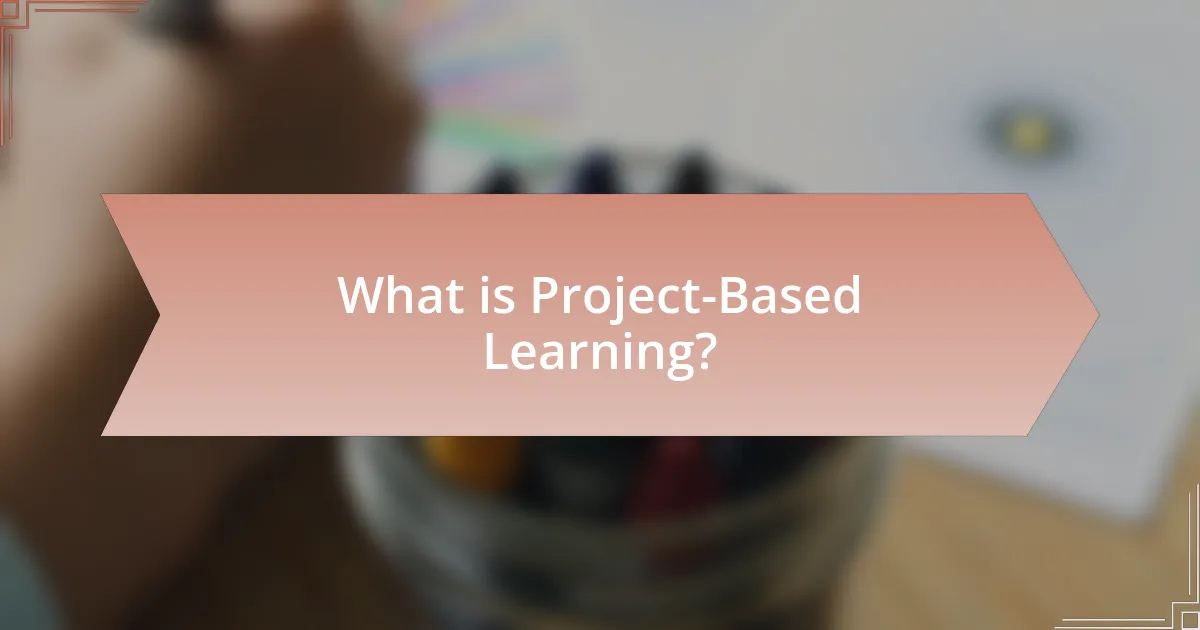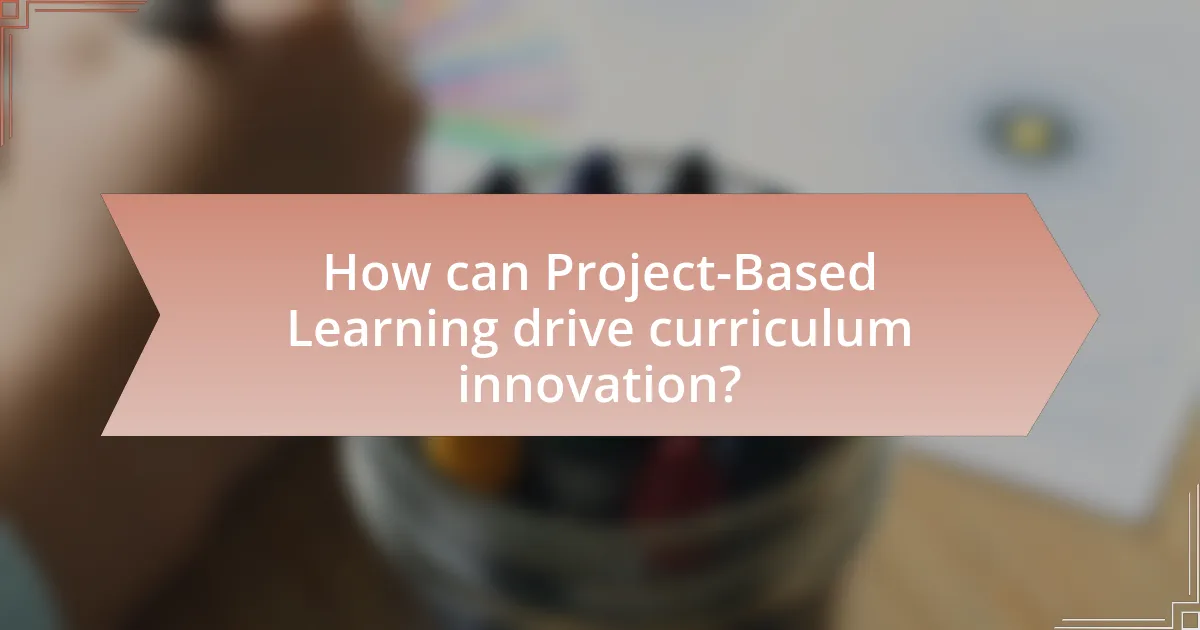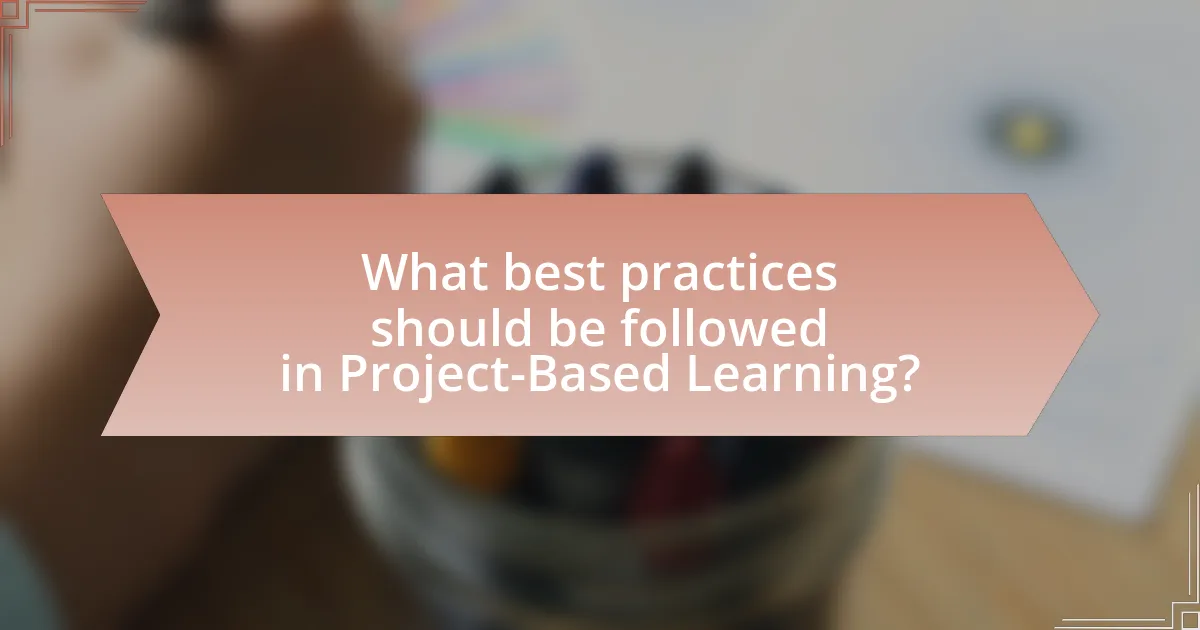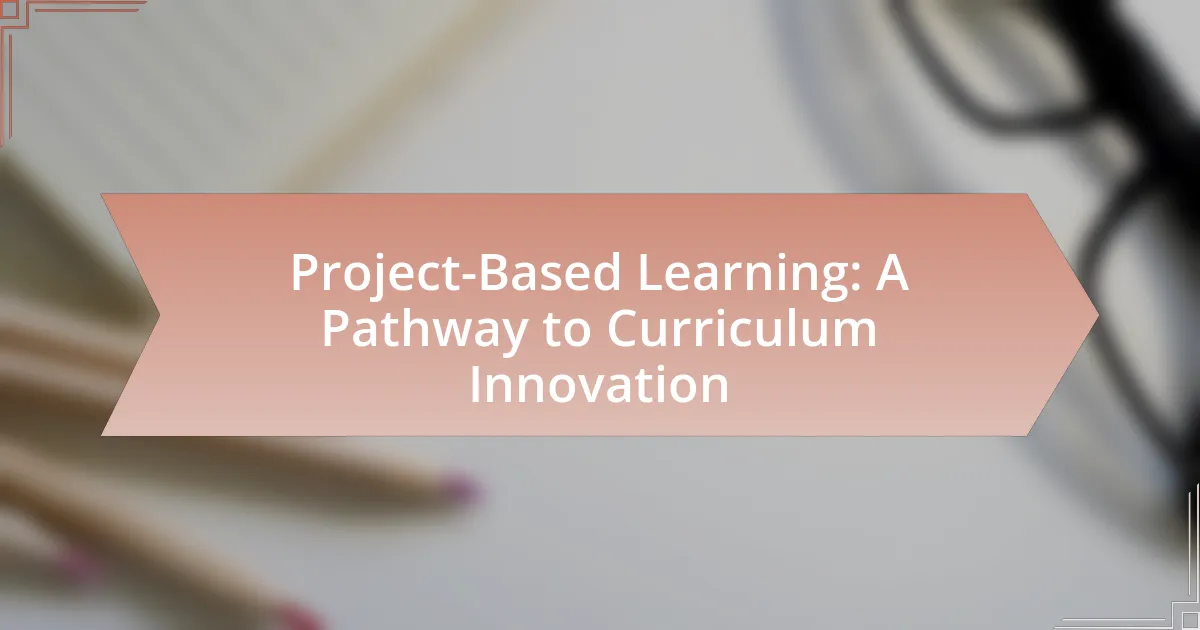Project-Based Learning (PBL) is an educational approach that engages students in hands-on projects addressing real-world problems, fostering critical thinking, collaboration, and retention of knowledge. This article explores the differences between PBL and traditional learning methods, highlighting key characteristics, essential components, and the importance of student engagement. It also discusses how PBL can drive curriculum innovation, enhance interdisciplinary learning, and improve assessment practices. Furthermore, the article outlines best practices for implementing PBL and the resources available to educators, emphasizing the positive outcomes associated with this dynamic learning approach.

What is Project-Based Learning?
Project-Based Learning (PBL) is an educational approach that engages students in learning through the completion of projects that address real-world problems or questions. This method emphasizes active learning, where students collaborate, research, and apply knowledge to create tangible outcomes. Research indicates that PBL enhances critical thinking, problem-solving skills, and retention of knowledge, as evidenced by a study published in the “Journal of Educational Psychology,” which found that students in PBL environments scored higher on assessments compared to those in traditional settings.
How does Project-Based Learning differ from traditional learning methods?
Project-Based Learning (PBL) differs from traditional learning methods by emphasizing hands-on, real-world projects as the primary mode of instruction, rather than passive absorption of information through lectures and rote memorization. In PBL, students engage in collaborative, inquiry-based tasks that require critical thinking, problem-solving, and application of knowledge, which contrasts with traditional methods that often focus on individual work and standardized testing. Research indicates that PBL enhances student engagement and retention of knowledge; for instance, a study published in the “Journal of Educational Psychology” by Thomas Markham found that students in PBL environments demonstrated higher levels of motivation and achievement compared to those in traditional settings.
What are the key characteristics of Project-Based Learning?
Project-Based Learning (PBL) is characterized by its focus on student-centered, inquiry-based learning through real-world projects. In PBL, students engage in complex tasks that require critical thinking, collaboration, and communication, allowing them to apply knowledge in practical contexts. Research indicates that PBL enhances student engagement and retention of knowledge, as evidenced by a study published in the Journal of Educational Psychology, which found that students in PBL environments demonstrated higher achievement levels compared to traditional learning methods. Additionally, PBL fosters the development of 21st-century skills, such as problem-solving and adaptability, which are essential for success in modern workplaces.
Why is student engagement important in Project-Based Learning?
Student engagement is crucial in Project-Based Learning because it directly influences the depth of understanding and retention of knowledge among students. Engaged students are more likely to take ownership of their learning, leading to higher motivation and better academic outcomes. Research indicates that when students are actively involved in projects, they develop critical thinking and problem-solving skills, which are essential for real-world applications. For instance, a study by the Buck Institute for Education found that students in project-based environments demonstrated improved collaboration and communication skills, essential competencies in today’s workforce. Thus, student engagement not only enhances individual learning experiences but also prepares students for future challenges.
What are the essential components of Project-Based Learning?
The essential components of Project-Based Learning (PBL) include a driving question, student voice and choice, a public product, collaboration, and reflection. A driving question serves as the focal point that guides the project, encouraging inquiry and exploration. Student voice and choice empower learners to make decisions about their projects, fostering engagement and ownership. The creation of a public product allows students to showcase their work to an audience, enhancing motivation and accountability. Collaboration among students promotes teamwork and communication skills, essential for real-world problem-solving. Finally, reflection enables students to evaluate their learning process and outcomes, reinforcing their understanding and skills. These components collectively enhance the educational experience by promoting active learning and critical thinking.
How do real-world problems enhance learning in Project-Based Learning?
Real-world problems enhance learning in Project-Based Learning by providing students with relevant, authentic contexts that foster engagement and critical thinking. When students tackle real-world issues, they apply theoretical knowledge to practical situations, which deepens their understanding and retention of concepts. Research indicates that students involved in project-based learning that incorporates real-world problems demonstrate improved problem-solving skills and higher motivation levels, as evidenced by a study published in the “Journal of Educational Psychology” by Thomas Markham, which highlights the correlation between real-world relevance and student achievement.
What role does collaboration play in Project-Based Learning?
Collaboration is essential in Project-Based Learning as it fosters teamwork, enhances problem-solving skills, and promotes deeper understanding of content. In collaborative settings, students engage in shared responsibilities, allowing them to learn from diverse perspectives and experiences. Research indicates that collaborative learning environments lead to improved academic outcomes; for instance, a study by Johnson and Johnson (2009) found that cooperative learning strategies can increase student achievement by 20-30%. This evidence underscores the significant role collaboration plays in enriching the educational experience within Project-Based Learning frameworks.
What outcomes can be expected from Project-Based Learning?
Project-Based Learning (PBL) leads to enhanced student engagement, improved critical thinking skills, and better retention of knowledge. Research indicates that students involved in PBL demonstrate higher levels of motivation and engagement compared to traditional learning methods, as evidenced by a study published in the “Journal of Educational Psychology,” which found that PBL can increase student achievement by up to 30%. Additionally, PBL fosters collaboration and communication skills, preparing students for real-world challenges. These outcomes collectively contribute to a more profound understanding of subject matter and the development of essential life skills.
How does Project-Based Learning impact critical thinking skills?
Project-Based Learning (PBL) enhances critical thinking skills by engaging students in real-world problem-solving and inquiry-based tasks. This active learning approach requires students to analyze information, evaluate solutions, and make decisions, fostering deeper cognitive processes. Research by Thomas Markham in “Project Based Learning Handbook” indicates that PBL promotes higher-order thinking skills, as students must synthesize knowledge from various disciplines to complete projects. Additionally, a study published in the “Journal of Educational Psychology” found that students participating in PBL demonstrated significant improvements in critical thinking assessments compared to traditional learning methods.
What evidence supports the effectiveness of Project-Based Learning?
Project-Based Learning (PBL) is supported by evidence indicating improved student engagement, retention, and critical thinking skills. Research conducted by the Buck Institute for Education shows that students involved in PBL demonstrate higher academic achievement compared to those in traditional learning environments. A meta-analysis by Thomas (2000) found that PBL enhances problem-solving abilities and promotes deeper understanding of content. Additionally, a study published in the Journal of Educational Psychology by Barron and Darling-Hammond (2008) revealed that PBL fosters collaboration and communication skills, essential for real-world applications. These findings collectively affirm the effectiveness of Project-Based Learning in educational settings.

How can Project-Based Learning drive curriculum innovation?
Project-Based Learning (PBL) can drive curriculum innovation by fostering a student-centered approach that emphasizes real-world problem-solving and collaboration. This method encourages educators to design curricula that are more relevant and engaging, aligning learning objectives with practical applications. Research indicates that PBL enhances critical thinking and creativity, as students actively participate in their learning process, leading to deeper understanding and retention of knowledge. For instance, a study by Thomas Markham in “Project Based Learning Handbook” highlights that PBL not only improves student engagement but also promotes the development of 21st-century skills, which are essential for success in modern workplaces.
What are the ways Project-Based Learning can transform curriculum design?
Project-Based Learning (PBL) can transform curriculum design by fostering student engagement, enhancing critical thinking skills, and promoting real-world application of knowledge. PBL shifts the focus from traditional rote learning to active exploration, allowing students to work on projects that require collaboration, problem-solving, and creativity. Research indicates that students involved in PBL demonstrate higher retention rates and improved understanding of complex concepts, as evidenced by a study published in the “Journal of Educational Psychology,” which found that students in PBL environments scored significantly higher on assessments compared to those in traditional settings. Additionally, PBL encourages interdisciplinary learning, integrating various subjects into cohesive projects, which reflects the interconnected nature of real-world issues. This approach not only aligns with educational standards but also prepares students for future challenges by developing essential skills such as teamwork and adaptability.
How does Project-Based Learning encourage interdisciplinary learning?
Project-Based Learning (PBL) encourages interdisciplinary learning by integrating multiple subjects into a single project, allowing students to apply knowledge and skills from various disciplines to solve real-world problems. This approach fosters collaboration among students, as they must communicate and work together, drawing on their diverse expertise in areas such as science, mathematics, and the arts. Research by the Buck Institute for Education indicates that PBL enhances critical thinking and problem-solving skills, which are essential for interdisciplinary connections. By engaging in projects that require the application of concepts from different fields, students develop a more holistic understanding of the subject matter, making learning more relevant and meaningful.
What strategies can educators use to integrate Project-Based Learning into existing curricula?
Educators can integrate Project-Based Learning (PBL) into existing curricula by aligning projects with curriculum standards and learning objectives. This alignment ensures that projects are relevant and meet educational requirements, facilitating a seamless incorporation of PBL. For instance, educators can design interdisciplinary projects that connect multiple subjects, such as combining science and art to explore environmental issues, thereby enhancing student engagement and understanding. Research indicates that PBL enhances critical thinking and problem-solving skills, as evidenced by a study from the Buck Institute for Education, which found that students engaged in PBL demonstrated higher retention of knowledge and improved collaboration skills. By utilizing these strategies, educators can effectively embed PBL into their teaching practices, fostering a more dynamic learning environment.
Why is curriculum innovation important in education?
Curriculum innovation is important in education because it enhances student engagement and prepares learners for real-world challenges. By integrating contemporary skills and knowledge into the curriculum, educational institutions can foster critical thinking, creativity, and collaboration among students. Research indicates that innovative curricula, such as those incorporating project-based learning, lead to improved academic outcomes and better retention of knowledge, as evidenced by a study published in the Journal of Educational Psychology, which found that students engaged in project-based learning scored significantly higher on assessments compared to those in traditional learning environments. This demonstrates that curriculum innovation is essential for developing relevant educational practices that meet the evolving needs of society and the workforce.
How does curriculum innovation address the needs of diverse learners?
Curriculum innovation addresses the needs of diverse learners by incorporating flexible, adaptive teaching methods that cater to various learning styles and backgrounds. This approach allows educators to design learning experiences that are relevant and engaging for all students, including those with different cultural, linguistic, and cognitive needs. For instance, project-based learning, a key component of curriculum innovation, promotes collaboration and critical thinking, enabling students to work together on real-world problems, which enhances their understanding and retention of knowledge. Research indicates that such inclusive practices lead to improved academic outcomes and greater student engagement, as evidenced by studies showing that diverse classrooms benefit from differentiated instruction and culturally responsive pedagogy.
What challenges do educators face when implementing curriculum innovation?
Educators face several challenges when implementing curriculum innovation, including resistance to change, lack of resources, and insufficient training. Resistance to change often stems from established practices and a reluctance to adopt new methodologies, which can hinder the integration of innovative approaches like project-based learning. Additionally, a lack of resources, such as funding, materials, and time, can limit the ability to effectively implement new curricula. Insufficient training for educators on innovative practices can lead to ineffective implementation, as teachers may not feel confident or equipped to facilitate new learning models. Research indicates that these challenges are prevalent in educational settings, impacting the successful adoption of innovative curricula.

What best practices should be followed in Project-Based Learning?
Best practices in Project-Based Learning (PBL) include clearly defined learning goals, real-world relevance, student choice, collaboration, and reflection. Clearly defined learning goals ensure that students understand the objectives and outcomes expected from the project. Real-world relevance connects the project to authentic issues or challenges, enhancing engagement and motivation. Student choice empowers learners to make decisions about their projects, fostering ownership and creativity. Collaboration encourages teamwork and communication skills, essential for success in both academic and professional settings. Reflection allows students to evaluate their learning process and outcomes, promoting deeper understanding and continuous improvement. Research by Thomas Markham in “Project Based Learning Handbook” emphasizes these practices as critical for effective PBL implementation.
How can educators effectively assess student learning in Project-Based Learning?
Educators can effectively assess student learning in Project-Based Learning by utilizing a combination of formative and summative assessments tailored to the project’s objectives. Formative assessments, such as peer reviews and self-assessments, provide ongoing feedback during the project, allowing students to reflect on their learning and make necessary adjustments. Summative assessments, including presentations and final project evaluations, measure the overall understanding and application of knowledge at the project’s conclusion. Research indicates that using rubrics can enhance the clarity of expectations and criteria for success, leading to more objective evaluations. For instance, a study by Thomas Markham in “Project Based Learning Handbook” emphasizes the importance of clear assessment criteria in improving student outcomes in project-based environments.
What assessment tools are most effective for Project-Based Learning?
The most effective assessment tools for Project-Based Learning include rubrics, self-assessments, peer assessments, and digital portfolios. Rubrics provide clear criteria for evaluating student work, ensuring consistency and transparency in grading. Self-assessments encourage students to reflect on their learning and identify areas for improvement, fostering metacognitive skills. Peer assessments promote collaboration and critical thinking as students evaluate each other’s contributions. Digital portfolios allow students to showcase their projects and document their learning journey, providing a comprehensive view of their skills and progress. Research indicates that these tools enhance student engagement and learning outcomes in project-based environments.
How can feedback be utilized to enhance learning outcomes in Project-Based Learning?
Feedback can be utilized to enhance learning outcomes in Project-Based Learning by providing timely, specific, and actionable insights that guide students in their project development. This approach allows students to reflect on their work, understand their strengths and weaknesses, and make necessary adjustments to improve their final products. Research indicates that formative feedback, which is given during the learning process rather than at the end, significantly boosts student engagement and achievement. For instance, a study by Hattie and Timperley (2007) found that effective feedback can increase student performance by up to 30%. By integrating structured feedback mechanisms, such as peer reviews and instructor evaluations, educators can foster a collaborative learning environment that encourages continuous improvement and deeper understanding of the subject matter.
What tips can educators use to successfully implement Project-Based Learning?
Educators can successfully implement Project-Based Learning (PBL) by clearly defining learning objectives and aligning projects with curriculum standards. This approach ensures that projects are relevant and meaningful, facilitating deeper engagement and understanding among students. Additionally, educators should encourage student voice and choice, allowing learners to select topics that interest them, which enhances motivation and ownership of their learning.
Collaboration is another critical element; educators should foster teamwork by designing projects that require students to work together, thereby developing essential communication and interpersonal skills. Regular reflection and feedback throughout the project process help students assess their progress and make necessary adjustments, reinforcing learning outcomes.
Research indicates that PBL can lead to improved student outcomes, with a study by Thomas Markham in “Project Based Learning Handbook” highlighting that students engaged in PBL demonstrate higher retention of knowledge and better problem-solving skills compared to traditional learning methods.
How can teachers foster a supportive environment for Project-Based Learning?
Teachers can foster a supportive environment for Project-Based Learning by promoting collaboration, providing clear guidelines, and encouraging student autonomy. Collaboration among students enhances teamwork skills and allows for diverse perspectives, which is essential in project-based settings. Clear guidelines help students understand expectations and project objectives, facilitating focused efforts. Encouraging student autonomy empowers learners to take ownership of their projects, fostering engagement and motivation. Research indicates that environments that support collaboration and autonomy lead to higher student achievement and satisfaction in project-based learning contexts.
What resources are available to assist educators in Project-Based Learning implementation?
Resources available to assist educators in Project-Based Learning (PBL) implementation include comprehensive guides, online platforms, and professional development programs. Notable resources are the Buck Institute for Education, which offers PBL training and project ideas, and Edutopia, which provides articles and videos on effective PBL strategies. Additionally, the Project-Based Learning Network connects educators for collaboration and sharing best practices. Research indicates that structured PBL frameworks enhance student engagement and learning outcomes, supporting the effectiveness of these resources in educational settings.

